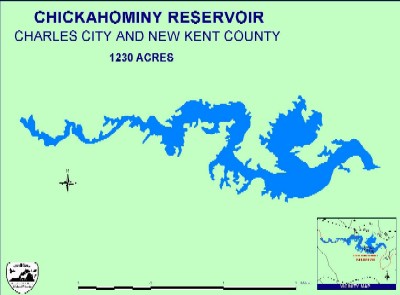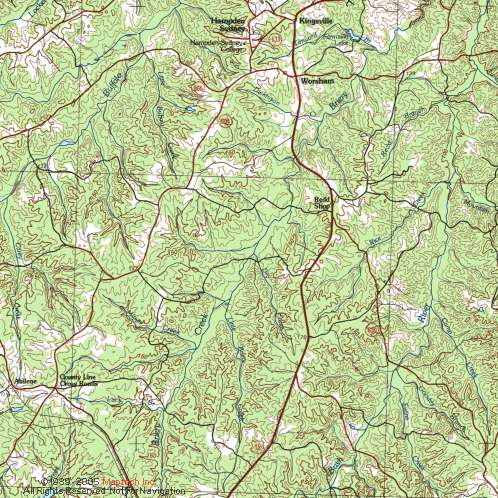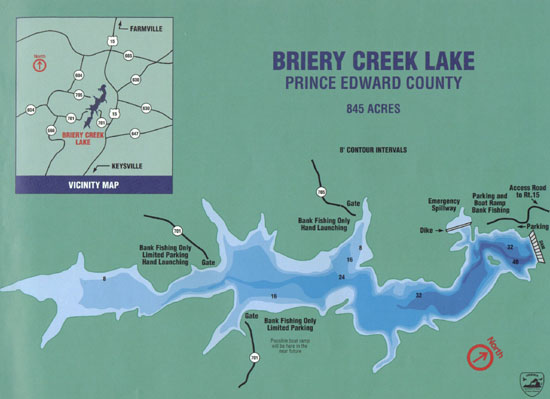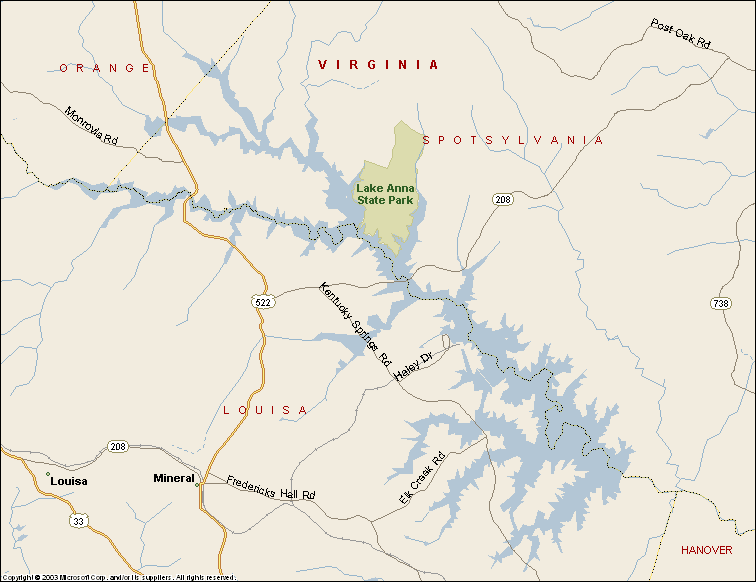Information gathered from Virginia Game and Inland Fisheries
Claytor Lake, a 4,475-acre impoundment of the New River, stretches northeastward across the Pulaski County countryside for 21 miles. Possible catches from Claytor Lake range from bass to carp. Smallmouth, largemouth, and spotted bass (collectively called “black bass”) are the “bread and butter” fishes of this lake. About 58 percent of the anglers at Claytor Lake fish for “black bass.” The three black bass species in Claytor Lake are regulated by a 12-inch minimum size limit and anglers may harvest five per day (all three species combined). Anglers are encouraged to practice catch-and-release of trophy-size bass from the lake. Claytor’s steep and rocky shorelines make it particularly good for smallmouth bass. In 2001, Claytor Lake produced 15 smallmouth bass certificates (more than five pounds or over 20 inches).
Claytor Lake holds fewer largemouth bass than other Virginia lakes, and they grow slowly in this mountain reservoir. Claytor Lake’s largemouth bass populations appear to be increasing. In 1990, largemouth bass made up about 10 percent of the black bass according to electrofishing catch results by fisheries biologists studying the lake. Largemouth bass increased to about 30 percent of the black bass electrofishing catch by 1998. Anglers can find this species in coves throughout the lake, but they are most abundant in Peak Creek. The Claytor Lake record for largemouth bass was a 14- pound, 6-ounce giant caught in June 1991.
Spotted bass in Claytor are generally smaller than the other black basses. They rarely reach 2 pounds in size. In fact, most anglers that think they are catching small largemouth bass are probably catching small spotted bass, particularly in the upper lake area (above Lighthouse Bridge) where spotted bass are more numerous.
Anglers fishing for black bass in the lake can use information collected on bass food habits during a recent study at Claytor Lake to select lures and techniques for these species. Smallmouth bass and spotted bass have very similar diets, with both relying mostly on crayfish. Techniques and lures that mimic crayfish are most likely to be successful in producing catches of these fish. Both of these bass species eat a lot of bluegill as well as some alewife and gizzard shad, so they may also hit lures that imitate fish. Largemouth bass diets are quite different than smallmouth and spotted bass diets, which may be one reason they are doing so well in the lake. Largemouth bass eat bluegill, alewife, gizzard shad, and crayfish, depending on the season of the year and whether these prey are abundant in a given year. Lures that imitate fish are the best choice for largemouth bass, but they may also hit crayfish imitations.
Fish
The Department maintains the striped bass population in Claytor Lake through annual stocking. The Department experimented with increased stocking rates for striped bass in Claytor Lake in 1998, 2001, and 2002. Doubling the stocking rate in 1998 and 2001, combined with good spawns of alewife and gizzard shad, has resulted in two prominent year classes of stripers in the lake. The 1998 stripers are now running from 28 to 32 inches in length and they weigh between seven and 12 pounds. The 2001 stripers are in the 15 to 18 inch range, so they will reach harvestable size in 2003. Recent sampling indicates that the some of the 2000 stripers will be represented in future catches at the lake. It is still too early to tell whether the 2002 stripers will produce similar numbers of adult fish to those from the 1998 and 2001 stockings.
Claytor Lake produced 15 certificate (more than 20 pounds or over 37 inches) stripers in 2001. At least one striper over thirty pounds in size is caught each year in this lake. Stripers can be caught year-round, although most anglers have their greatest success from late September through May. Water temperatures at or below 70 degrees seem to produce the best fishing.
Recent striper diet studies at Claytor Lake showed that stripers rely mostly on alewife and gizzard shad. Therefore, it is no surprise that Claytor Lake anglers experience the best success using these species as bait. Gizzard shad and alewives are most easily caught using a cast net near the back ends of coves. Peak Creek is a great place for finding bait, but don’t overlook smaller coves in the lake. Many stripers are taken with topwater baits (Redfins, Rapalas, etc.) and bucktails in the spring and fall. Fish points and flats adjacent to deep water for best topwater action. Trolling bucktails in 20-60 feet of water can produce good catches.
During the summer and early fall months stripers primarily “hole up” in the middle and lower lake areas close to the lake’s thermocline (30-40 feet deep), where they find suitable temperature and oxygen levels. When the lake begins to cool in October, stripers begin chasing shad and alewife schools around the lake and are more difficult to locate. If you are lucky enough to see them chasing shad at the surface, you can catch them on top water lures. In winter months, look for stripers in the middle and upper lake areas, from the mouth of Peak Creek up to the Lighthouse Bridge. At this time of year, a good depth finder is the single most important piece of equipment needed to locate fish, because stripers are likely to be located in 40-60 feet of water. Find the bait schools and you are likely to find the stripers nearby.
Hybrid striped bass were introduced to Claytor in 1992 and are stocked each year. Many of the fish from the earliest stockings are 8-12 pounds today! These striped bass hybrids are a hard fighting fish that are good to eat! Since they can tolerate higher water temperatures, hybrids often chase schools of shad at the lake’s surface at night in the summer months. Most of the time, hybrids live at similar depths and locations as the stripers in the lake. Their diet is very similar to stripers, so they can be caught using the same techniques.
White bass are found in Claytor Lake, but their numbers are down from historic levels. The best opportunity to catch white bass from the lake is during April and May when they run upstream to Allisonia, where the New River flows into Claytor Lake.
Anglers should keep in mind that the harvest of stripers and hybrids is limited to 4 fish per day (the two species combined), all of which must be longer than 20 inches. White bass are regulated by a creel limit of five per day, with no size limit. Anglers should study the differences between these fish carefully. Helpful identification information is available in the Department’s recent publication, “The Angler’s Guide to Virginia Freshwater Sportfish,” which is available from Department offices statewide.
Walleye are still occasionally caught from the lake, but their numbers have dropped off since stocking was discontinued in 1996. Anglers have recently been catching yellow perch in the one-pound range. Black crappie caught from the lake typically average a little less than a pound. According to the Department’s creel survey in 1998, many anglers take home a limit of 25 bluegill that average 0.5-pound each. Flathead and channel catfish (up to 20 pounds) can also be caught from the lake. With catches of 20-30 pound carp possible, anglers from as far away as England come to fish for them at Claytor.
Claytor Lake State Park
Claytor Lake State Park, located on the north side of the lake, provides 497 acres of park with camping, cabins, picnic areas, and a swimming beach, as well as a marina. For more information on the park, call 540-643-2500.
Boat Access
Boat access to the lake is available for a small fee at private ramps at Claytor Lake State Park, Lighthouse Bridge, and at Conrad Brothers and Rockhouse Marinas on the Peak Creek arm of the lake. The Department maintains no-fee ramps at Allisonia (in the upper lake area) and near the entrance to the state park (Dublin Ramp). Harry’s Point boat ramp, a no-fee ramp located in the mid-lake area within Pulaski County’s Harry DeHaven Park, has a double ramp and courtesy piers. Harry’s Point also has a handicapped-accessible fishing pier, where many of the lake’s species can be caught throughout the year. During the fall and winter months, anglers are likely to catch striped bass and hybrid striped bass swimming near the pier.
Directions
The easiest way to get to Harry’s Point from I-81 is to take the Route 605 exit (near the south end of Radford), and then follow the brown trailblazer signs to Harry DeHaven Park. From the I-81 exit ramp, take Route 605 (Little River Dam Road). Follow Route 605 until you reach Route 663 (Owens Road), go right on 663, then look for signs marking the park when you get near the lake.
If you have fishing questions about Claytor Lake, call the VDGIF Blacksburg office at 540- 951-7923.



